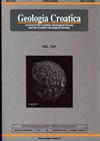Evidence and mineralogical and physico-chemical properties of chernozem and chernozem-like soils in Croatia
IF 1.1
4区 地球科学
Q3 GEOLOGY
引用次数: 0
Abstract
The aim was to determine possible local differences between the parent materials of recent leoss-derived soils in eastern Croatia (Dalj, Zmajevac). Furthermore, it highlights the existence of chernozem and chernozem-like soils in Croatia and describes their basic physical, chemical and mineral properties. For this purpose, two soil profiles (P-3 and P-6) south of the Dalj settlement and one soil profile (P-10) near the Zmajevac settlement were excavated. The investigation included a detailed pedological analysis, a modal analysis of the heavy and light mineral fraction and a mineralogical analysis of bulk samples (the < 2 mm fraction) and the fraction < 2 μm. By comparing the obtained results with the criteria of the Croatian Soil Classification and the World Reference Base for Soil Resources, the soil profiles P-3 and P-6 can be defined as Chernozem on Loess or Hortic Calcic chernozem (Epiloamic, Endosiltic, Aric, Humic). The systematic unit for profile P-10 was defined as Rendzina according to the Croatian Soil Classification or Calcic Chernozem (Siltic) according to the WRB. Based on the results of the pedological analysis of the soil profile horizons, a gradual degradation of the chernozem was observed as a result of anthropogenic influence, but also due to recent climate change. The degradation is particularly evident in the form of a reduction in organic matter and the relocation of carbonates from the surface to deeper zones. Due to the increasing degree of weathering caused by recent climate changes, some differences in the mineralogical composition of the studied soils were also observed. The progressive degradation of the chernozem due to the effects of recent weathering processes is indicated mainly by the presence of goethite in the fraction < 2 μm as a weathering product of iron minerals (magnetite, pyroxenes…). Although the parent material of all three profiles is loess sediments, the reason why the soil material of profile P-10 has not developed a chernic horizon is the constant contribution of aeolian material and a short period of exposure to pedogenetic processes.克罗地亚黑钙土和类黑钙土的矿物学和物理化学特征
目的是确定克罗地亚东部(Dalj, Zmajevac)最近的黄土土壤母质之间可能存在的地方差异。此外,它强调了克罗地亚黑钙土和类黑钙土的存在,并描述了它们的基本物理、化学和矿物性质。为此,在Dalj聚落以南的两个土壤剖面(P-3和P-6)和Zmajevac聚落附近的一个土壤剖面(P-10)进行了挖掘。调查包括详细的土壤学分析,重矿物和轻矿物组分的模态分析以及散装样品的矿物学分析(<2 mm馏分)和馏分<2μm。将所得结果与克罗地亚土壤分类标准和世界土壤资源参考基地的标准进行比较,可以将土壤剖面P-3和P-6定义为黄土黑钙质或土钙质黑钙质(epiloic, Endosiltic, Aric, Humic)。剖面P-10的系统单位根据克罗地亚土壤分类定义为Rendzina或根据WRB定义为钙质黑钙质(硅质)。根据土壤剖面层的土壤学分析结果,观察到黑钙土逐渐退化,这是人为影响的结果,但也是由于最近的气候变化。这种退化特别明显,表现为有机质减少和碳酸盐从地表向深层迁移。由于近年来气候变化引起的风化程度增加,研究土壤的矿物组成也出现了一些差异。黑钙土受近期风化作用的影响而逐渐退化,主要表现为<中针铁矿的存在;2 μm为铁矿物(磁铁矿、辉石等)风化产物。虽然3个剖面的母质均为黄土沉积物,但P-10剖面的土质未发育成地层的原因是风成物质的持续贡献和暴露于成土过程的时间较短。
本文章由计算机程序翻译,如有差异,请以英文原文为准。
求助全文
约1分钟内获得全文
求助全文
来源期刊

Geologia Croatica
GEOSCIENCES, MULTIDISCIPLINARY-
CiteScore
2.90
自引率
23.10%
发文量
35
审稿时长
>12 weeks
期刊介绍:
Geologia Croatica welcomes original scientific papers dealing with diverse aspects of geology and geological engineering, the history of the Earth, and the physical changes that the Earth has undergone or it is undergoing. The Journal covers a wide spectrum of geology disciplines (palaeontology, stratigraphy, mineralogy, sedimentology, petrology, geochemistry, structural geology, karstology, hydrogeology and engineering geology) including pedogenesis, petroleum geology and environmental geology.
Papers especially concerning the Pannonian Basin, Dinarides, the Adriatic/Mediterranean region, as well as notes and reviews interesting to a wider audience (e.g. review papers, book reviews, and notes) are welcome.
 求助内容:
求助内容: 应助结果提醒方式:
应助结果提醒方式:


